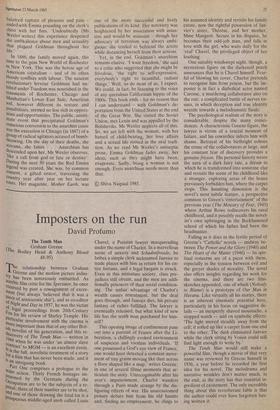Imposters on the run
David Profumo
The Tenth Man Graham Greene (The Bodley Head & Anthony Blond £6.95) The relationship between Graham Greene and the motion picture indus- try has been notoriously embattled. As acerbic film critic for 'the Spectator, he once received by post a consignment of excre- ment (but always 'believed that it was a Piece of aristocratic shit'), and as co-editor °f Alight and Day in 1937, he was the victim legal proceedings from 20th-Century Fox for his review of Shirley Temple. His Particular involvement with the cinema is more important than that of any other Brit- 1811 novelist of his generation, and this re- dtscovery of The Tenth Man — written in 1944 when he was under 'an almost slave e, i contract' to MGM — is an excellent event. i is the full, novelistic treatment of a story for a film that has never been made, and it Is an intriguing book. Part One comprises a prologue to the nialn action. Thirty French hostages im- prisoned by the Germans during the ucc upation are to be the subjects of a re- prisal; three of their number are to be shot, and one of those drawing the fatal lot is a Prosperous middle-aged snob called Louis Chavel, a Parisian lawyer masquerading under the name of Chariot. In a marvellous scene of anxiety and Schadenfreude, he bribes a simple clerk nicknamed Janvier to trade places with him in return for his en- tire fortune, and a legal bargain is struck. Even in this miniature society, class pre- judices still obtain, and the men are addi- tionally prisoners of their social condition- ing. The unfair advantage of Chariot's wealth causes resentment, but the deal goes through, and Janvier dies, his private fantasy of riches fulfilled. The lawyer is eventually released, but what kind of new life has the tenth man purchased for him- self?
This opening image of confinement pans out into a portrait of France after the Li- beration, a chillingly evoked environment of suspicion and rootless individuals. 'If one possessed a God's eye view of France, one would have detected a constant move- ment of tiny grains moving like dust across a floor shaped like a map,' writes Greene, in one of several filmic moments that ar- ticulate the story. Unrecognisable after his year's imprisonment, Chariot wanders through a Paris made strange by the dis- figuring effects of war. His unaccustomed penury debars him from his old haunts and, finding no employment, he clings to
his assumed identity and revisits his family estate, now the rightful possession of Jan- vier's sister, Therese, and her mother, Mme Mangeot. Secure in his disguise, he becomes their odd-job man, and falls in love with the girl, who waits daily for the `real' Chavel, the privileged object of her loathing.
One suitably windswept night, though, a mysterious figure on the darkened porch announces that he is Chavel himself. Fear- ful of blowing his cover, Charlot pretends to recognise him from prison, but the im- poster is in fact a diabolical actor named Carosse, a murdering collaborator also on the run; a complicated battle of nerves en- sues, in which deception and true identity wrestle towards a melodramatic finale.
The psychological realism of the story is considerable, despite the many coinci- dences. A characteristic Greene figure, the lawyer is victim of a crucial moment of failure, and his cowardice infects him with shame. Betrayal of his birthright echoes the crime of the collaborators at large, and his constant fear of discovery provides a genuine frisson. His personal history wears the aura of a dark fairy tale, a dream in which he is transformed into someone else and revisits the scene of his childhood like a stranger, exploring areas of the house previously forbidden him, where the carpet stops. This haunting dimension is the novel's most subtle feature, a perspective common to Green's 'entertainment' of the previous year (The Ministry of Fear, 1943) where Arthur Rowe rediscovers his rural childhood, and it possibly recalls the novel- ist's own upbringing in the Berkhamsted school of which his father had been the headmaster.
Falling as it does in the fertile period of Greene's 'Catholic' novels — midway be- tween The Power and the Glory (1940) and' The, Heart of the Matter (1948) — its spir- itual concerns are of a piece with them, especially in the tension between evil and the greyer shades of morality. The novel also offers insights regarding his work for the cinema, and there are two film- sketches appended, one of which (Nobody to Blame) is a prototype of Our Man in Havana. Like virtually all his stories, there is an inherent cinematic potential here, particularly in his focus on suggestive de- tails — an inexpertly shaved moustache, a stopped watch — and on symbolic effects: The light moved steadily away from the cell; it rolled up like a carpet from one end to the other. The dusk eliminated Janvier while the clerk sitting by Voisin could still find light enough to write by.'
The Tenth Man would still make a powerful film, though a movie of that very name was reviewed by Greene himself in 1936, a year before he recorded the first idea for his novel. The melodrama and narrative wrinkles don't matter much, in the end, as the story has that essential in- gredient of excitement. The only incredible thing about this reverberant fable is that the author could ever have forgotten hav- ing written it.














































 Previous page
Previous page